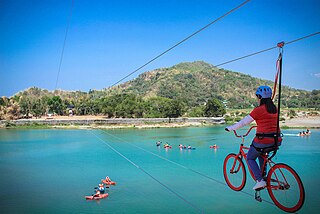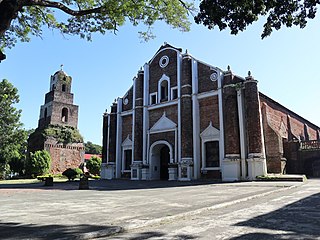
Ilocos Norte, officially the Province of Ilocos Norte, is a province of the Philippines located in the Ilocos Region. Its capital is Laoag City, located in the northwest corner of Luzon Island, bordering Cagayan and Apayao to the east, and Abra to the southeast, and Ilocos Sur to the southwest. Ilocos Norte faces the West Philippine Sea to the west and the Luzon Strait to the north.

Laoag, officially the City of Laoag, is a 3rd class component city and capital of the province of Ilocos Norte, Philippines. According to the 2020 census, it has a population of 111,651 people.

The Church of Saint Augustine, also known as the Archdiocesan Shrine of Our Lady of Consolation and Cincture or the Immaculate Conception Parish, is a Roman Catholic church under the auspices of the Order of Saint Augustine located inside the historic walled city of Intramuros in Manila, Philippines. Completed in 1607, it is the oldest stone church in the country.

Sarrat, officially the Municipality of Sarrat, is a 4th class municipality in the province of Ilocos Norte, Philippines. According to the 2020 census, it has a population of 25,186 people.

Vintar, officially the Municipality of Vintar, is a 1st class municipality in the province of Ilocos Norte, Philippines. According to the 2020 census, it has a population of 33,339 people.

Earthquake Baroque, or Seismic Baroque, is a style of Baroque architecture found in the former Spanish East Indies and in Guatemala, which were Spanish-ruled territories that suffered destructive earthquakes during the 17th and the 18th centuries. Large public buildings, such as churches, were then rebuilt in a Baroque style during the Spanish colonial periods in those countries.

The Baroque Churches of the Philippines are a collection of four Spanish Colonial-era baroque churches in the Philippines, which were included in UNESCO's World Heritage List in 1993. The churches are also considered as national cultural treasures of the country.

The legislative districts of Ilocos Norte are the representations of the province of Ilocos Norte in the various national legislatures of the Philippines. The province is currently represented in the lower house of the Congress of the Philippines through its first and second congressional districts.

The Archdiocese of Nueva Segovia is an archdiocese of the Catholic Church in the Philippines. It covers the province of Ilocos Sur, on the island of Luzon. The see of the archdiocese is the city of Vigan.

GV. Florida Transport, Inc., previously known as Florida Liner, is a Philippine bus company headquartered in Barangay Matucay Allacapan, Cagayan, and operates a fleet of buses that provide transportation services to various destinations in Northern Luzon. It was founded by Virgilio Florida, Sr., in 1970. The company was incorporated in 1999 and is currently managed by brothers George Florida and Virgilio Florida, Jr., along with Harry D. Florida, Chief Operator Executive, the current municipal mayor of Allacapan, Cagayan.

The Diocese of Laoag is a Latin Church ecclesiastical jurisdiction or diocese of the Catholic Church in the Philippines.

The Santa Monica Parish Church, commonly known as the Sarrat Church, is a Roman Catholic parish church in Barangay San Leandro, Poblacion, Sarrat, Ilocos Norte, Philippines. It was built in 1779 and was originally known as San Miguel Church. The Santa Monica Church complex includes the convent connected to the church by an elevated three-level brick stairway.

Laoag Cathedral, canonically known as Saint William's Cathedral is a Roman Catholic church in Laoag City, Ilocos Norte, Philippines. The current church was built in 1612 by Augustinian friars to replace a wooden chapel. It also serves as the seat or central church of the Roman Catholic Diocese of Laoag.

The Saint Augustine Church, commonly known as the Paoay Church, is a Roman Catholic church in the municipality of Paoay, Ilocos Norte in the Philippines. Completed in 1710, the church is famous for its distinct architecture highlighted by the enormous buttresses on the sides and back of the building. It is declared as a National Cultural Treasure by the Philippine government in 1973 and a UNESCO World Heritage Site under the collective group of Baroque Churches of the Philippines in 1993.

Paoay Lake is a lake within the municipality of Paoay, in northwestern Luzon, Philippines. It is the largest lake in the province of Ilocos Norte and one of the largest natural lakes in the area.

The Santo Tomás de Villanueva Parish, also known as Miagao Church, is a Roman Catholic church located in Miagao, Iloilo, Philippines. The church was declared as a UNESCO World Heritage Site on December 11, 1993, together with San Agustin Church in Manila; Nuestra Señora de la Asuncion Church in Santa Maria, Ilocos Sur; and San Agustin Church in Paoay, Ilocos Norte under the collective title Baroque Churches of the Philippines, a collection of four Baroque Spanish-era churches.

The Santa Ana Parish Church, commonly known as the Piddig Church, is a Roman Catholic parish church in Piddig, Ilocos Norte, Philippines. Originally a visita of Dingras, it was raised into an independent parish in 1770. In September 2014, the 200-year-old church of Saint Anne Parish in Piddig, Ilocos Norte was closed for public worship after it was deemed unsafe.

Dingras Church is a Roman Catholic church located in the municipality of Dingras, Ilocos Norte, Philippines under the jurisdiction of the Roman Catholic Diocese of Laoag.

The Malacañang of the North is a presidential museum in Paoay, Ilocos Norte, Philippines. It was the residence of the family of Ferdinand Marcos when he was the President of the Philippines.























